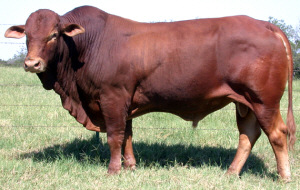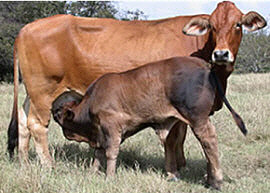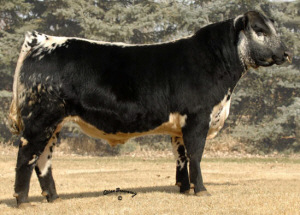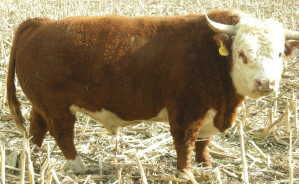



Brahmousin
History
The Brahmousin was created in the late 1970's by Daryl Wiggins in Texas. The first of the breed were produced from a multiple embryo transfer from a French-imported Limousin dam called Gloria. This resulted in six heifers and three bull calves which formed the Limousin base. The stock was then cross bred to Brahman cattle which achieved an F-1 cross, and further crosses over a broader base led to the 5/8 to 3/8 purebred.
 Photo courtesy of Hilltop Farms, www.brahmousincattle.com |
The goal was to blend the best of the Limousin and Brahman traits, this created a breed that have excellent reproductive efficiency, mothering ability, excel in muscling and growth traits and are adaptable in varying environmental conditions.
Purebred Brahmousin are classified as five-eighths Limousin and three-eighths Brahman. This mix has been found to be the most widely accepted and most useful for the majority of the United States.
Characteristics
The Brahmousin is generally golden red to tan in colour, the legs, around the eyes, muzzle and underbelly are a lighter shade. Their skin is slightly loose like the Brahman. It is a large breed with a strong frame and beefy conformation.
The bulls are rugged, thick, fertile and are active breeders, the females are broody, long lasting and fertile, and also and display carcass quality.
This breed takes qualities such as the heat tolerance, insect resistance and feed efficiency from the Brahman and the excellence in muscling and growth traits, carcass quality and conformation from the Limousin to make a very useful American breed.
 Photo courtesy of Hilltop Farms, www.brahmousincattle.com |
Statistics
Comparative
Distribution
This breed is produced mainly in the USA and Australia.
References (the above information was cited from the following sites)
www.americanbrahmousincouncil.org
www.brahmousincattle.com


